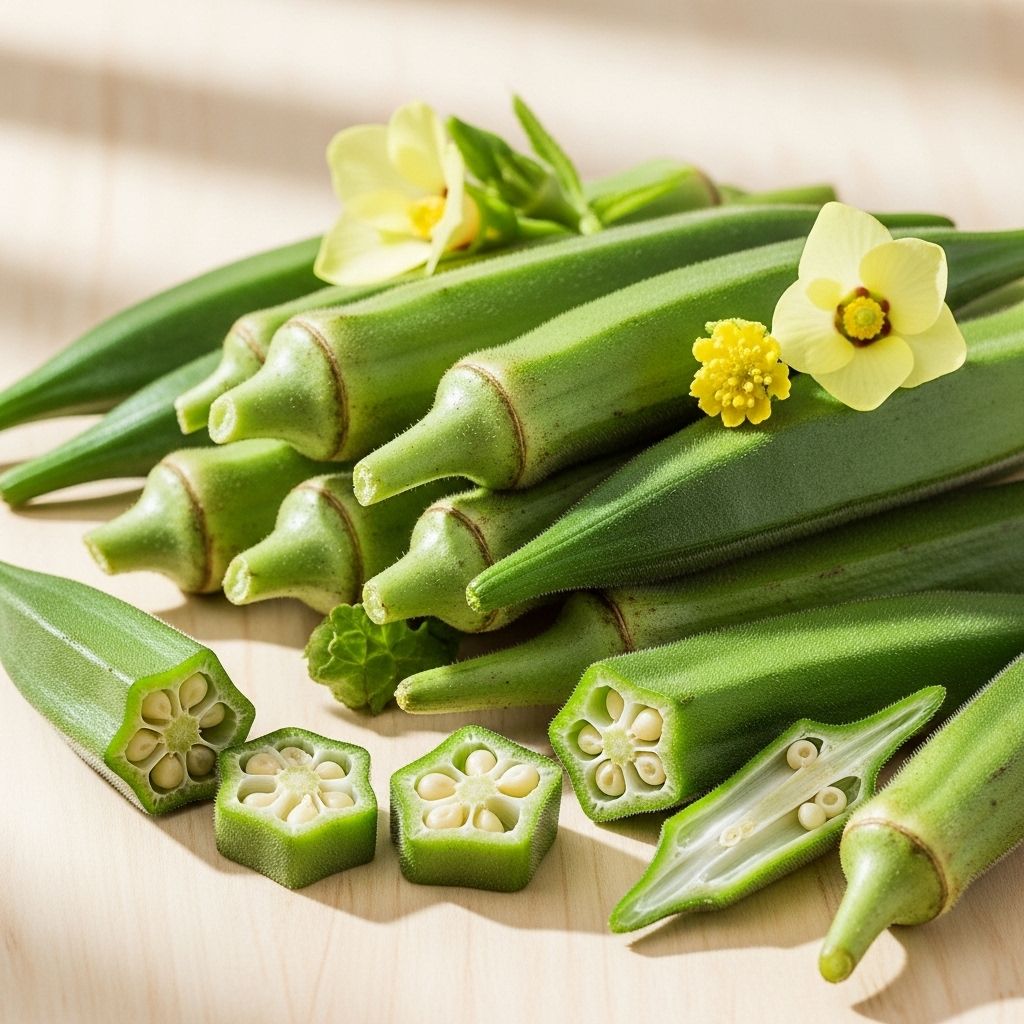Okra: Benefits, Uses, and Taste
A go-to ingredient for adding velvety texture and wholesome goodness to diverse recipes.

Table of Contents
- Introduction to Okra
- Description
- Health Benefits
- Culinary Uses
- Taste
- Frequently Asked Questions (FAQs)
Introduction to Okra
Okra, commonly known as Abelmoschus esculentus, is a warm-season vegetable belonging to the mallow family (Malvaceae). Native to the tropics of the Eastern Hemisphere, it is widely cultivated and naturalized in tropical and subtropical regions worldwide. Okra is popularly recognized by its edible fruit, which is consumed in various parts of the world.
Description
Okra plants are typically grown as an annual in temperate climates and can reach heights of up to 2 meters (6 feet 7 inches). The leaves are palmately lobed with five to seven lobes, measuring 10 to 20 cm (4 to 8 inches) in length. The flowers are similar to hibiscus, with five white to yellow petals that often feature a red or crimson center. The fruit pods are 10 to 25 cm (4 to 10 inches) long, covered with fine hairs, and contain numerous small, oval seeds.
Health Benefits
Okra is renowned for its nutritional value, providing a wealth of minerals, vitamins, antioxidants, and fiber. Some of the key health benefits associated with okra include:
- Rich in Antioxidants: Okra contains phenolic compounds and flavonoid derivatives, which may help reduce the risk of chronic diseases such as cancer.
- Fiber Content: The soluble fiber in okra can aid digestion and help manage blood sugar levels.
- Mineral and Vitamin Source: Okra is a good source of iron, niacin, phosphorus, and copper, among other essential nutrients.
- Potential Health Risks Reduction: Regular consumption of okra may help reduce the risk of obesity, diabetes, and cardiovascular diseases due to its high dietary fiber content.
Culinary Uses
Okra is a versatile ingredient used in various cuisines worldwide. It is often employed to thicken soups and stews, due to the mucilaginous properties of its pods. Some popular dishes include:
- Gumbo: A classic dish from the southern United States, where okra is used as a thickening agent.
- Pickling: Okra pods are frequently pickled to preserve them and add flavor.
- Fried Okra: A popular side dish in many cultures, where okra is breaded and deep-fried.
- Stews and Soups: Okra is a common ingredient in hearty stews and soups, particularly in African and Middle Eastern cuisines.
Taste
Okra has a mild, slightly sweet taste with a unique texture that can be described as slightly crunchy. The mucilaginous consistency, which becomes noticeable when cooked, is a distinguishing feature of okra. However, the texture can vary depending on the cooking method:
- Steaming: Helps retain okra’s crunchy texture and flavor.
- Sauteing: Can reduce the sliminess if cooked quickly.
- Deep-Frying: Creates a crispy exterior that masks the sliminess.
Frequently Asked Questions (FAQs)
Q: Where Does Okra Originate From?
A: Okra is believed to have originated from the tropics of the Eastern Hemisphere, specifically East Africa, and was introduced to the Americas from Western Africa.
Q: What Is the Mucilage in Okra?
A: The mucilage is a gelatinous substance found in okra pods, which is used to thicken soups and sauces.
Q: Can Okra Be Grown at Home?
A: Yes, okra can be grown at home in warm climates. It is a heat-tolerant plant and can thrive in well-drained soil with full sunlight.
References
- https://www.britannica.com/plant/okra
- https://en.wikipedia.org/wiki/Okra
- https://www.medicalnewstoday.com/articles/311977
- https://gardeningsolutions.ifas.ufl.edu/plants/edibles/vegetables/okra/
- https://pmc.ncbi.nlm.nih.gov/articles/PMC7865958/
- https://www.missouribotanicalgarden.org/PlantFinder/PlantFinderDetails.aspx?taxonid=282605
- https://plants.ces.ncsu.edu/plants/abelmoschus-esculentus/
- https://www.ams.usda.gov/grades-standards/okra-grades-and-standards
Read full bio of medha deb












